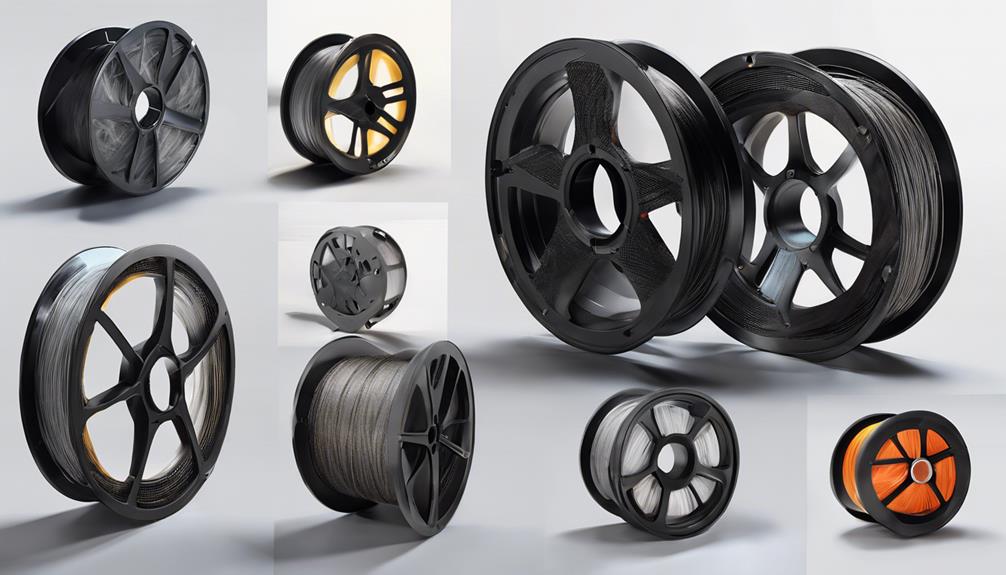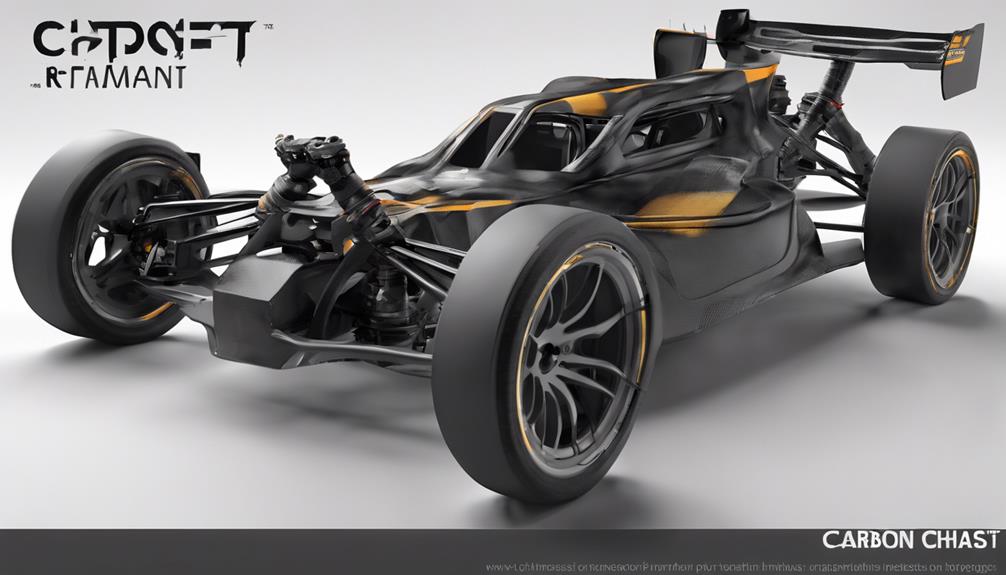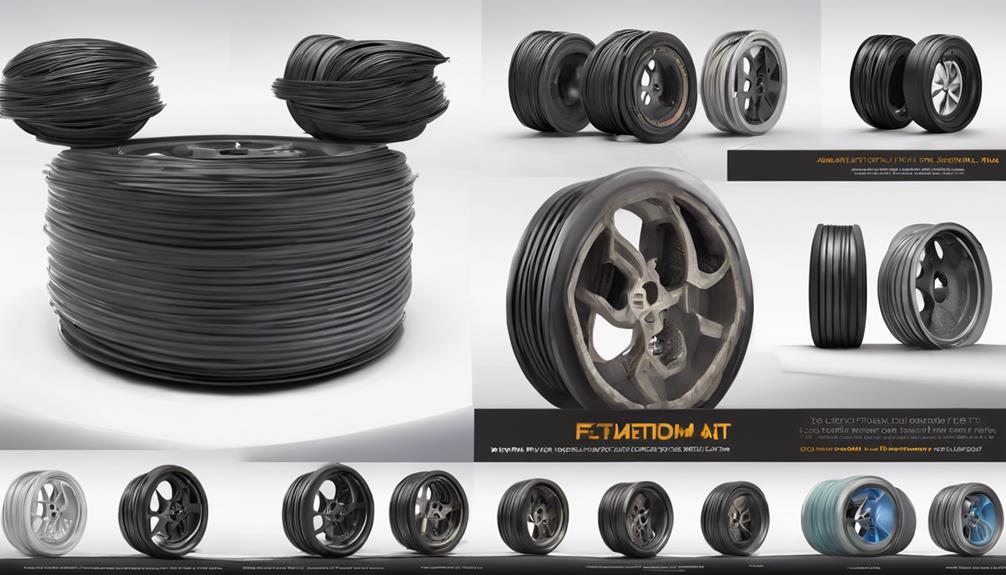Exploring the domain of filament choices for RC parts can greatly enhance the performance of these components. The selection of the right filament is pivotal in determining the durability and functionality of RC structures. However, the delicate balance between strength, flexibility, and resilience remains an important aspect that demands attention. In this regard, understanding the nuances of various filament types and their impact on RC performance is essential. Stay tuned to discover how the top filament choices can revolutionize the way RC enthusiasts approach their vehicle customization.
Strength and Temperature Resistance Filaments

When considering filament options for RC parts that require high strength and temperature resistance, certain types such as ABS, Polycarbonate, ASA, and PETG stand out as excellent choices due to their specific properties and performance characteristics.
ABS is popular for its strength and durability, although it lacks UV resistance. Polycarbonate offers exceptional tensile strength and UV resistance but is challenging to print with.
ASA provides high impact and UV resistance, making it ideal for harsh weather conditions. PETG, with 70% strength of polycarbonate, is easy to print and offers good impact and UV resistance.
Each filament type has its unique advantages, catering to different needs in the domain of RC parts fabrication.
Challenging Polycarbonate Filaments
Mastering the complexities of printing with Polycarbonate filaments presents a significant challenge for 3D printing enthusiasts seeking unparalleled strength and UV resistance in their RC parts. Polycarbonate offers a tensile strength of around 9,800 PSI and can withstand weights up to 685 pounds, making it an ideal choice for durable components. However, its high printing requirements and challenging nature may not be practical for hobbyist printers. Despite these challenges, Polycarbonate's UV resistance for 5-15 years makes it a valuable option for parts exposed to sunlight.
| Strengths | Challenges | Practicality |
|---|---|---|
| High tensile strength | Challenging to print | Not ideal for hobbyist printers |
| UV resistant for years | Requires high printing requirements | Durable components |
| Can withstand heavy loads | Not beginner-friendly | Ideal for parts exposed to sunlight |
High Impact ASA Filaments

High Impact ASA Filaments offer exceptional durability and resilience, making them a top choice for RC parts requiring robust performance. When considering these filaments for your RC projects, keep in mind the following key points:
- Durability: ASA filaments are known for their high impact resistance, ensuring that your RC parts can withstand rough handling and challenging environments.
- Weather Resistance: These filaments excel in harsh weather conditions, making them ideal for outdoor RC applications where exposure to the elements is a concern.
- UV Resistance: ASA filaments offer excellent UV resistance, ensuring that your RC parts maintain their strength and integrity even when exposed to sunlight over extended periods.
PETG Strength and UV Resistance
PETG filament is renowned for its exceptional strength and UV resistance, making it a preferred choice for various RC parts that demand durability and longevity. PETG offers around 70% of the strength of polycarbonate while being highly rated. It has a print temperature ranging between 230°C – 250°C and a bed temperature between 70°C – 85°C. Its impact and UV resistance properties make it sought-after for RC car parts, known for being easy to print.
| PETG Filament Properties | Details |
|---|---|
| Strength | 70% of polycarbonate |
| Print Temperature | 230°C – 250°C |
| Bed Temperature | 70°C – 85°C |
| Impact Resistance | High |
| UV Resistance | Excellent |
Filament Selection for RC Chassis

When selecting filaments for RC chassis applications, it is essential to take into account the specific requirements of the chassis design and performance expectations.
- Material Strength: Choose a filament with high impact resistance to guarantee the chassis can withstand crashes and rough terrains.
- Temperature Resistance: Opt for a filament that can handle the operating temperatures of the RC vehicle to prevent deformation or failure during use.
- Ease of Printing: Consider filaments that are easy to work with and suitable for your 3D printer setup to ensure a smooth printing process and high-quality results.
Preferred Filament for RC Cars Body
For RC cars bodies, choosing the right filament is essential to guarantee durability and performance under varying conditions. When it comes to the body of an RC car, PETG filament is a preferred choice due to its balance of strength and printability. PETG offers approximately 70% of the strength of polycarbonate but is easier to print with, making it popular for hobbyist printers.
Additionally, PETG is impact-resistant and UV resistant, ensuring longevity and reliability for RC car bodies. While ASA filament also provides UV and impact resistance, PETG stands out for its ease of printing, making it a practical and efficient choice for creating durable and high-performance RC car bodies.
Specific Filament Recommendations for RC Car Parts

When choosing filament for RC car parts, it is crucial to take into account the specific requirements of each component to ensure excellent performance and durability.
- Filament for RC Car Bumpers:
- Bumpers need to absorb impacts and be strong.
- Nylon or TPU with high infill percentage offer strength and flexibility.
- Nylon is strong and flexible, ideal for bumpers.
- Filament for 3D Printed Springs:
- Printing springs can be challenging but feasible.
- MakeFast Workshop devised a method for printing springs.
- Nylon is a good choice for springs due to strength and flexibility.
- Practical Considerations and Application of Filaments in RC Models:
- Guidelines on filament choices for RC Cars Body.
- Experimenting with different filaments for varied results.
- Consider individual needs of each part for a successful final object.
Frequently Asked Questions
Can ABS Filaments Be Used for Outdoor RC Car Parts?
ABS filaments can be used for outdoor RC car parts due to their strength and impact resistance. However, ABS lacks UV resistance, so parts may degrade over time. Consider applying a UV-resistant coating for prolonged durability.
What Are the Challenges of Printing With Polycarbonate Filaments?
Printing with polycarbonate filaments is akin to mastering a complex puzzle; it requires precise settings and high temperatures. Challenges include warping, bed adhesion issues, and potential nozzle clogging. Patience and expertise are key for successful prints.
Are There Any Safety Precautions When Using ASA Filaments?
When using ASA filaments, safety precautions are vital. Due to their high extrusion and bed temperatures, proper ventilation is essential to mitigate hazardous fumes. Personal protective equipment, like respirators, should be worn to guarantee safety.
How Does PETG Compare to Polycarbonate in Terms of Strength?
PETG and polycarbonate both offer strength, but PETG falls slightly short compared to polycarbonate. PETG provides around 70% of polycarbonate's strength. While PETG is highly rated and easy to print, polycarbonate boasts superior tensile strength.
What Is the Best Filament for Printing RC Car Chassis With Entry-Level Printers?
When considering the best filament for printing RC car chassis with entry-level printers, ABS stands out due to its lower printing temperature, making it more suitable for beginners. ABS offers acceptable results for internal RC parts, balancing strength and ease of use.
Conclusion
To sum up, choosing the right filament for RC parts is essential for enhancing performance. Different filaments offer unique strengths such as high impact resistance, temperature tolerance, and UV resistance.
Experimenting with various filaments can optimize the overall performance of RC vehicles. According to a recent study, using the correct filament can increase the durability and longevity of RC parts by up to 30%.